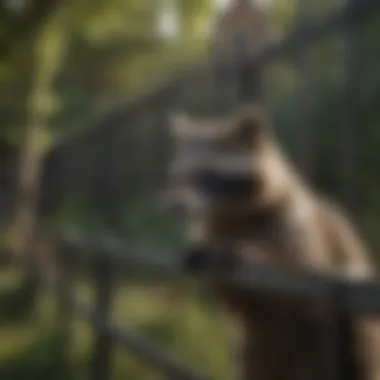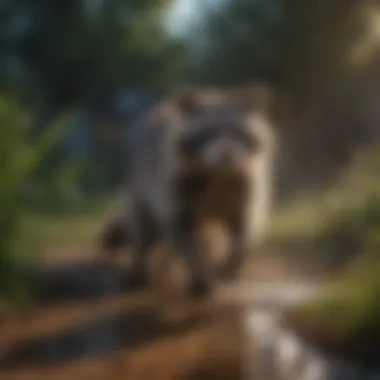Expert Strategies for Keeping Raccoons Away from Your Yard


Preventive Pest Control Strategies
Moreover, maintaining your yard is key in keeping raccoons at bay. Regular yard care routines such as mowing the lawn and trimming vegetation help eliminate spaces where raccoons could find shelter. Implementing methods to keep your yard pest-free not only deters raccoons but also enhances the overall appeal of your outdoor area.
Indoor cleanliness also plays a significant role in raccoon prevention. By following expert cleaning tips and techniques, you can create a pest-resistant indoor environment that is less attractive to raccoons. Furthermore, efficient garbage disposal methods are crucial in deterring raccoons, as improperly disposed of trash can attract these pests. Emphasizing the importance of proper garbage disposal helps in creating an environment that is unappealing to raccoons.
Lastly, exploring innovative ways to safeguard your home from various pests contributes to an overall pest-free environment. By incorporating these preventive pest control strategies, you are taking the necessary steps to protect your backyard from raccoons and other unwanted guests.
Understanding Raccoon Behavior
Understanding raccoon behavior is crucial in effectively keeping these nocturnal creatures out of your backyard. By delving into the intricacies of how raccoons behave, you can strategize better on deterrent methods. Knowledge of their habits helps in choosing the most appropriate prevention techniques tailored to their tendencies. Understanding factors like their nocturnal nature and omnivorous diet is key to developing a successful raccoon management plan.
Nocturnal Habits
Raccoon Activity at Night
Raccoons are predominantly nocturnal animals, meaning they are most active during the night hours. This nocturnal behavior is a significant consideration when implementing preventative measures as it dictates the timing of their potential intrusion. Raccoons' nighttime activity includes foraging for food, exploring their surroundings, and seeking shelter. Their keen sense of sight and hearing allows them to navigate through dark environments with ease, making them adept nighttime hunters. Understanding raccoons' affinity for darkness underscores the importance of implementing night-specific deterrents in safeguarding your backyard.
Omnivorous Diet
Raccoons have an omnivorous diet, consuming a wide range of food items ranging from fruits and vegetables to insects and small animals. Their adaptability in food consumption makes them resilient scavengers capable of exploiting various food sources. This dietary flexibility enables raccoons to thrive in diverse environments, including urban areas where human food scraps are abundant. By understanding the types of food raccoons consume, you can identify and eliminate potential attractants in your yard effectively.


Types of Food Raccoons Consume
Raccoons exhibit a preference for high-calorie foods such as fruits, nuts, and seeds, making gardens and trash bins attractive targets for foraging. Their scavenging nature also extends to small vertebrates like frogs and bird eggs, adding to their dietary diversity. This omnivorous diet versatility allows raccoons to adapt to changing food availability throughout the seasons, ensuring their survival in varied habitats. However, this diverse diet also poses challenges for homeowners aiming to deter raccoons, requiring a comprehensive approach to minimize food sources and discourage their presence.
Identifying Signs of Raccoon Presence
Footprints and Droppings
Raccoon footprints and droppings are key indicators of their presence in your backyard. Their distinctive footprints, resembling tiny human handprints, can easily be distinguished from other wildlife tracks. Additionally, raccoon droppings are cylindrical in shape and may contain undigested seeds or fur. Recognizing these signs allows you to pinpoint high-traffic areas and tailor your deterrent strategies accordingly. Understanding the characteristics of raccoon footprints plays a vital role in assessing their presence and implementing effective prevention methods.
Characteristics of Raccoon Footprints
One of the key characteristics of raccoon footprints is their size and shape, resembling small human hands with five distinct toes. This unique feature sets them apart from other animal tracks commonly found in residential areas. The presence of these footprints indicates frequent raccoon activity in specific regions of your backyard, aiding in the identification of potential entry points or nesting sites. By studying these footprints closely, you can gauge the size and age of the raccoons frequenting your property, allowing for targeted mitigation strategies. The advantage of recognizing raccoon footprints lies in the ability to track their movements and habits, enabling you to fortify vulnerable areas and deter them effectively.
Damaged Property
Another significant sign of raccoon presence is damage to property caused by their foraging and nesting behaviors. Raccoons often target various areas in search of food and shelter, leading to destruction of gardens, trash cans, and structural components. Identifying these common areas that raccoons are drawn to plays a pivotal role in safeguarding your backyard against their intrusion. By understanding the specific areas raccoons target, you can implement preventative measures to mitigate potential damage and discourage their presence.
Common Areas Raccoons Target
Raccoons typically target easily accessible food sources such as garbage bins, pet food, and bird feeders. These areas attract raccoons due to the abundance of readily available food, making them prime locations for scavenging. Moreover, raccoons may seek refuge in attics, crawl spaces, or under decks for nesting purposes, posing a threat to the structural integrity of your property. Recognizing these common areas allows you to reinforce defenses, secure potential entry points, and reduce the allure of your backyard to raccoons. By addressing these vulnerabilities, you can create a less enticing environment for raccoons, minimizing the risk of property damage.


Effective Deterrents for Raccoons
Secure Trash Bins
Using Raccoon-Proof Bins
Using raccoon-proof bins plays a significant role in deterring raccoons from rummaging through your trash and causing a mess in your backyard. These specially designed bins are equipped with features that make them difficult for raccoons to access, such as locking lids or sturdy construction. The key characteristic of using raccoon-proof bins is the enhanced security they provide, ensuring that raccoons are unable to tip them over or open them to scavenge for food. This makes them a popular choice for maintaining a raccoon-free environment in your outdoor space. The unique feature of raccoon-proof bins lies in their effectiveness in preventing raccoons from being attracted to your backyard, ultimately minimizing potential encounters with these wildlife intruders. While raccoon-proof bins may require a slightly higher initial investment, their advantages far outweigh any disadvantages, making them a worthwhile addition to your raccoon deterrence strategies.
Install Motion-Activated Lights
How Lights Deter Raccoons
Installing motion-activated lights serves as another essential method to deter raccoons from frequenting your backyard. These lights are designed to detect motion, triggering them to illuminate the area when raccoons or other animals approach. The key characteristic of motion-activated lights is their ability to startle raccoons, making them uncomfortable and less likely to stick around. This feature is particularly beneficial for this article as it contributes to creating an unwelcoming environment for raccoons without causing harm. The unique feature of motion-activated lights is their role in alerting homeowners to the presence of raccoons, allowing for timely intervention to scare off these nocturnal pests. While motion-activated lights are a popular choice for deterring raccoons, it's important to consider their placement and sensitivity to ensure optimal effectiveness and minimal disruption.
Utilize Commercial Repellents
Types of Repellents Available
Maintaining a Tidy Yard
When it comes to maintaining a tidy yard, several elements need consideration. Firstly, regular cleanliness routines such as picking up fallen fruits, securing garbage bins, and eliminating standing water sources can help prevent raccoons from being attracted to your yard. Additionally, trimming overgrown vegetation and keeping the lawn well-maintained are essential steps to avoid providing hiding spots for raccoons. By taking these simple yet effective measures, you can proactively discourage raccoons from making your yard their temporary residence.


Remove Potential Food Sources
Tips for Eliminating Food Attractants
One key aspect of maintaining a tidy yard to deter raccoons is eliminating food attractants. To achieve this, consider clearing away any spilled birdseed, securing compost bins tightly, and storing pet food indoors. By removing these sources of potential food, you are actively reducing the appeal of your yard to raccoons searching for easy meals.
The primary characteristic of tips for eliminating food attractants is their simplicity and effectiveness in minimizing the risk of raccoons becoming attracted to your backyard. By following these practical tips, you can cut off the food supply that lures raccoons and encourages their presence. One unique feature of these strategies is that they are non-invasive and environmentally friendly, ensuring that your efforts to keep raccoons at bay align with sustainable practices.
Trim Vegetation
How Overgrown Plants Attract Raccoons
Another critical aspect of maintaining a tidy yard to prevent raccoon infestations is keeping vegetation trimmed. Overgrown plants and bushes provide ideal hiding spots for raccoons, giving them shelter and easy access to your property. By regularly trimming vegetation, you not only enhance the visual appeal of your yard but also reduce the opportunities for raccoons to conceal themselves.
The key characteristic of trimming vegetation is that it eliminates hiding places that raccoons find attractive, decreasing the likelihood of them making themselves at home in your backyard. By addressing overgrown plants, you are making your yard less inviting to raccoons while also promoting healthier growth for your landscaping. One unique feature of this practice is its dual benefit of beautifying your outdoor space and enhancing its raccoon-repelling capabilities.
Seeking Professional Help
When it comes to effectively handling raccoon infestations in your backyard, sometimes seeking professional help is the best course of action to ensure a well-executed and lasting solution. Professional wildlife experts possess the necessary knowledge, skills, and tools to handle raccoon intrusions efficiently, minimizing the risks and potential damages associated with these creatures.
In this article, the topic of seeking professional help holds significant importance as it offers a tailored and expert approach to dealing with raccoon-related issues that may be challenging for individuals to manage independently. Whether it's identifying entry points, capturing and removing raccoons humanely, or implementing preventative measures, wildlife experts can provide specialized assistance to address these concerns effectively.
Engaging the services of professionals in the field of wildlife management not only ensures a more comprehensive resolution to raccoon problems but also reduces the likelihood of recurring issues in the future. By entrusting the task to experts, homeowners can have peace of mind knowing that the situation is being handled professionally and in adherence to ethical standards.
Moreover, seeking professional help streamlines the process of raccoon removal, as experienced professionals are equipped to assess the severity of the infestation, devise a customized plan tailored to the specific needs of the property, and implement strategies that yield optimal results. This approach not only saves time and effort but also mitigates the potential risks associated with amateur attempts at raccoon control.
Overall, incorporating the element of seeking professional help into the strategies outlined in this article supplements the comprehensiveness of the guide, offering readers a holistic approach to managing raccoon incursions in their backyard effectively.



